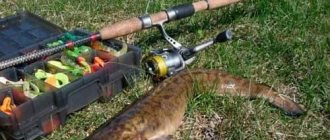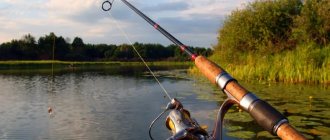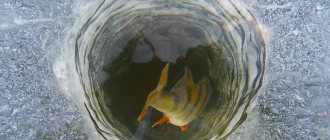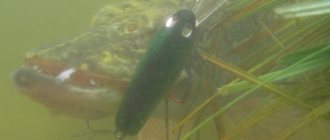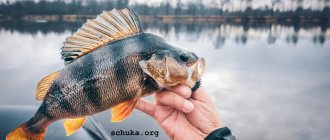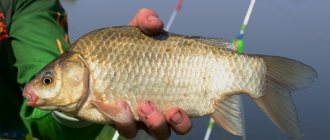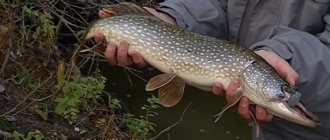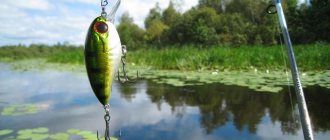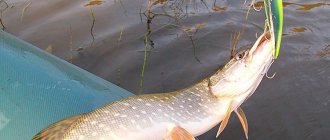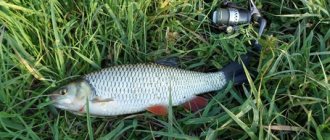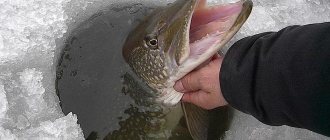Fishing in the fall has its own characteristics. Reservoirs become more transparent, baits practically do not perform their function, because... the fish becomes shy and hides in secluded places. Autumn fishing requires special equipment and gear.
It is also necessary to take into account many nuances of fishing at this time of year.
Features and advantages of autumn fishing
When autumn comes, the air and water temperatures drop. This affects the fish bite, because... it is becoming scarce. Many anglers are interested in where the fish go in the fall. At this time of year, it rushes to the depths, where the water is warmer. Bait for autumn fishing practically becomes unnecessary, because... During this period, it is difficult to lure fish to one place.
It is difficult to get a good catch from the shore. It is best to fish from a boat or use long casting. The most catchy places include deep holes located near the rifts.
In autumn, the fish becomes sleepy and inactive, so anglers must adhere to special tactics that can help them get a good catch. During this period, the fish takes the bait with caution, so rough gear should not be used.
It is recommended to use thin line and small floats. In autumn, the fish’s diet changes, so night fishing is most often excluded.
Good zhor is observed in ide, pike and bream. September is considered the most productive month, delighting fishermen with a rich catch. Autumn fishing is preferred by spinning anglers, because... Perch and pike are starting to be actively caught.
Net fishing in the fall is mainly used for catching silver carp. Popper fishing for pike is often carried out. Fishing in late autumn gradually becomes ice fishing.
The main advantage of autumn fishing is the feeling of peace. In autumn, there are fewer vacationers on the river banks, which allows you to take the best places.
But there is an autumn fishing ban due to spawning. The duration of the ban varies and depends on the region. Most often, the restriction lasts from September 1 to November 15.
On the river
In the fall, the fish gather in large schools and begin to feed heavily before the onset of winter. The water in the river is made much cleaner, so fishing in small areas that lack shelter becomes fruitless, because... the fish feels unprotected in them and tends to quickly go to other places.
In autumn, increased migration of fish is observed on small rivers.
There are no wintering pits in such reservoirs, and a school of fish migrates to larger rivers or various lakes. Therefore, fishing in one place every weekend, you can find the following trend: at first, silver bream, chub, and roach are caught well, the next weekend - only small bleak.
Starting in September, cool places start to empty out. The fish occupy their wintering places and refuse to leave them. The exception is night fishing for bream. When fishing on a large river, bream goes out in search of food most often at night. In the morning it rolls back into the pits and eats nothing.
Pike tackle: aiming for versatility
Since I do most of my fishing trips exclusively in places with a lot of snags, I choose a more powerful spinning rod, which can easily spin a pike and literally rip it out of the underwater snags. I have three main requirements for pike tackle: power, sensitivity and versatility.
It is advisable to have one working bait in different colors
Power is needed so that you can easily pull out a pike using the “crane method”, throwing it onto a high bank. And the “sense” will allow you to track the most accurate bites. Since I fish on small rivers mainly with jigs, but sometimes also use wobblers, I need a universal spinning rod with a slight bias towards jig. Fast action spinning rods cope with this task. Bass spinning rods meet all the above criteria well, but, however, this pleasure is not cheap.
The best option for my conditions are spinning rods 210 or 220 cm long with a dough of up to 21 grams. In places where the river is wide and the banks are not very high, I use a specialized Maximus Gravity jig spinning rod with a test weight of up to 12 g. And this is a rare case when a spinning rod with such a test has the ability to forcibly pull a pike out of snags. And when fishing in the strongest places, you have to use coarser gear - for example, the Palms Jetta bass “short” with a test of up to 21 g. But in order to actively move without unnecessary load, I take only one of these spinning rods with me for fishing, and which one depends from the intended route and proposed fishing spots.
Since the width of the river is generally no more than four meters, and in some sections the river practically turns into a stream, there is simply no need for a long spinning rod, and with a “shorty” one it is much easier to move through thickets of thorns and other impassable vegetation.
The hook from “Spike” does not catch on snags, but it catches pike
On one and the other spinning rod I put a reel in size 2500 on the Shimano scale, but with different spools: for a spinning rod up to 12 g I have a “braid” with a diameter of #0.8 (0.148 mm) wound, and for the other tool - #1.35 (0.195 mm) .
The leash is strongly bent - this means the pike is active
As for the braided cord, I don’t use eight-core, because... Due to constant contact with driftwood, it begins to fluff intensively. There is no need for a long casting distance, but reliability and strength are extremely important, so I almost always use a four-core cord. Last season, the Power Phantom PE4 braided line performed well. It is durable, and most importantly, it retains its qualities for a long time, and this is very important when fishing in snags.
What kind of fish and in which bodies of water is best to catch?
Many anglers are interested in what fish bite in the fall. The most common fish caught during this period are:
- silver bream;
- crucian carp;
- carp;
- bream;
- burbot;
- perch;
- roach;
- pike perch;
- pike.
In October, silver bream is caught well. It is advisable to go fishing on a warm sunny day. The fish most often lives in deep and quiet places where the water is warm and the bottom is covered with silt or clay.
In early September, crucian carp are caught near the shore. Plant components are used as bait, and a worm is used as bait. Fishing is often done with a jig from the shore.
At the end of September, crucian carp rush to the deep-water parts of the river, and in October they should be looked for at a depth of 2-4 m. In this case, bloodworms are used as bait, and barley serves as bait.
In November, crucian carp settle down for the winter at the bottom. It is recommended to catch it in warm weather, because fish become more active in warm water. There is no need to feed it, and the bait is left motionless.
In September, carp begin a period of active feeding, especially in warm and calm weather. If the weather is windy and rainy, then the fish hides at the bottom. It does not require bait, and maggots of a large earthworm and grain pellets are used as bait.
Read: Features of carp fishing in October
Bream is found in large lakes, large and medium-sized rivers. Prefers to live in deep holes, creeks and places with a muddy bottom. It is best to catch this fish in September, choosing clear, windless days for fishing. It is recommended to go out early in the morning or in the evening to fish.
Read: Bream fishing in autumn
Burbot is caught in November in the coastal zone. They go fishing at night. Gudgeon or ruffe are used as bait.
Perch lives in any part of the reservoir. Most often found near the shore or in a place where there is a lot of vegetation. The fish bite best in the morning and evening hours. They catch it mainly using spinning rods.
In September, roach lives in places where there is a quiet current and deep holes. They are caught using baits such as bloodworms, maggots, worms, etc. In October-November, fish should be looked for in shallow holes near steep banks. Maggots, larvae, bloodworms, and worms are used as bait.
In the fall, pike perch can be caught using both live bait and artificial bait. To achieve maximum catch, use jig baits. It lives in pools or deep dark pits.
Read: What do autumn pike perch bite on?
In autumn, pike have a strong hunger. You can meet her not far from the shore. To catch a predator in the fall, the following gear is used: spinning rod, float, circles, paths, donks, girders, etc.
Video: Pike fishing on the river in autumn
Autumn zhor of pike. Spinning fishing from a boat on the river using wobblers.
Fishing for pike in the fall is an exciting and exciting activity. You need to go out on a quiet hunt after the start of the seasonal feeding season, when the water has cooled and the weather is cool. It is best to catch pike in the fall from a boat. You can find the predator in snags and in aquatic thickets. Wobblers, spinners, or live bait are used as bait.
Views: 757
Gear used
Autumn fishing involves the use of the following gear:
- spinning;
- float rod;
- feeder
Spinning
Spinning is a tackle that is recommended for catching predatory fish. It is often used for autumn fishing. At this time of year, pike perch and pike are intensively fattening up before the oncoming cold weather, so spinning rods are effective fishing equipment.
The rod should be light and withstand heavy loads. The spinning reel should have 120 m of line with a thickness of 0.3 mm.
Float rod
Float gear is used for fishing. Most often, roaches are caught using a float rod. Such a fishing rod should have maximum sensitivity and accuracy. Use a fishing line with a diameter of 0.06−0.8 mm, a hook No. 20−22, and a float with a carrying capacity of 0.2−0.4 g.
Thanks to a lightweight rod 6-8 m long with a soft tip, the equipment is delivered to the fishing point. On rivers in the fall you can collect a large catch on a float.
Feeder
The feeder is most often used for summer fishing, but in the fall it is used for catching bream. During the cold season, fish rush further from the shore to greater depths, so long casting is necessary. The length of the rod must be at least 4 m.
Bream in cool water is inactive, which means a soft rod tip that can repel even the smallest bites. Fishing equipment should also be ultra-thin with a light feeder. There is also a thin fishing line with a diameter of 0.1 mm and small hooks.
Fishing in late autumn (October, November)
On small rivers and narrow Volga channels, predators are very poorly caught at the end of October. Most of the fish roll from here to deep water, where they are caught with varying success until the freeze-up. But some of the predatory fish still remain in small rivers.
SMALL RIVERS IN PRE-WINTER
Fish leave small rivers quickly: four days ago I was fishing in the Volga channel and caught quite well. Pike, ide, asp and perch were biting consistently, and today I’ve already checked a kilometer of the channel, and there’s only one pike in my backpack. The water is clear in autumn, the bright sun illuminates the shallow coastal waters, but no fish are visible. At the very end of the open water season, it is rare to catch anything in such places, so catching a pike is already good luck.
By autumn, the water becomes crystal clear, and this makes fishing even more difficult. Camouflage is necessary in everything - you need to hide your own presence and make some elements of the gear invisible.
With the arrival of cold weather and the first snow, fish from small rivers move to greater depths. Now it’s pointless to fish in shallow riffles and under the grass; it’s worth looking for deeper depths. But there are exceptions here too. Sometimes at the very end of the open water season, when the snow may fall and not melt, you can get a good bite of pike and perch in shallow coastal waters, but always under reeds or reeds.
Areas with considerable depth on small rivers are quite long, and fishing them takes a lot of time. Late autumn fishing is more about torture at one point, rather than a constant search with rapid movement. There are no outstanding edges here, only snags remain.
The question arises - how to catch these same snags? In cold water, predatory fish respond better to vertical retrieves than to horizontal ones, so jig baits are preferable. The classic jig starts working at depths greater than 1.5 m.
Sometimes, in especially cramped conditions, horizontal wiring is impossible in principle. Pendulum cast a couple of meters under the snag, cast in the fall phase, and, raising the rod, pull out the bait and again make a pendulum cast. This technique of constantly “slotting” under one snag works very well. Don't get discouraged after the first few casts. As practice shows, a predator can attack from the tenth or fifteenth cast to one place.
The most important question in such places is what bait to use? Of course, each situation has its own solution. During spinning practice there were many cases when a spinner bait acted as the best bait. I would like to tell you about two of the most exciting cases.
FIRST CASE: STUMPS AND SNAGWAYS
At its mouth this river is full-flowing and wide, but at the source and in the middle reaches there is a small trickling stream, heavily snagged in places. When the water level on the Volga drops closer to autumn, almost all the snags in the river become noticeable. At such times I like to visit its sources and catch pike and large perch in them. Twisters with light weights and offset driftwood equipment are successful, but the fish are poorly detected: out of ten that bite, at best 3–4 will be brought ashore. In the pre-winter period, however, there are not very many bites here, and this percentage of hooks is critical.
Going to the river this time, I took with me the entire set of baits. I wanted to compare the spinner bait with regular jigs.
At the very beginning of the river there are whole piles of snags that are not easy to get around. I know from experience that the bait must be brought close to such shelters, sometimes dragged right through them, which can lead to snagging. I'm worried about the spinner bait - after all, it cost 150 rubles - and I throw it into the thick of it. I make the wiring wavy, sometimes lowering it to the bottom under the snags, sometimes raising it almost to the surface. During the wiring, I shuffled across the drifts about seven times. But after a few casts, such a shuffling retrieve brought the first bite: a good perch flew out from under the stump and, bristling with thorns, boldly attacked the petal. The hook caught him under his lower jaw.
Ten casts into the thick of the snags – not a single hook and one successful bite. The statistics may be small, but excellent!
There are a lot of different kinds of driftwood here. At the source there are rubble, after a few tens of meters stumps begin to stand alone at the bottom, which are hidden under one and a half meters of water. After several empty trips through the rubble, I move to the stumps. Stumps are visible on the water as dark spots. Here I run the spinner bait with a classic jig, only occasionally diversifying it with swaying movements on the descent. The spinner bait works well in all phases of the retrieve - the petals rotate even when lowering.
I predicted the bite. When the bait approached the stump, I stopped the wiring, lightning flashed from under the stump, fiercely pressing the sinking spinner bait! Fishing in these places, I got used to a large number of empty bites. But now, after the hook, I felt the jerks of the hooked pike, which, with sharp movements of its head, rose higher and higher to the surface until it made a dazzling candle.
At the end of August, there was one pike under each stump, but now many of the stumps are empty. There are not many stumps here, and among them there are even favorites. One of them, located directly opposite the birch tree on the opposite bank, consistently brought pike all summer. From under it we managed to catch a personal best on this river - a pike of just over three kg. So now I’ve decided to stay on it longer. I've already caught it with a dozen casts, but to no avail. Each time I tried to bring the bait closer to the trunk, to go right up to it; passive pikes really like such passages. And at the end of the next jig step, I felt that the spinner bait hit the top of the stump. I carefully pulled it off and within a second I felt a poke! The pike we caught was quite tiny, about 250 grams, and this explained its shyness; after all, a spinner bait is a voluminous bait. Her bite once again confirmed that presentation is much more important than the appearance of the bait. But one cannot discount such characteristics of the bait as cross-country ability and detection ability. On a spinner bait that late autumn day, I felt seven bites in one day. Of these, six fish - three pike from 250 to 1300 grams and three perch from 100 to 300 grams - were delivered to the shore. A spinner bait is a solid “A” when it comes to catching snags that are very different in their constitution. By the end of the day, to tell the truth, he remained on one of them, but not every bait can withstand a hundred casts in such difficult conditions and detect fish so well.
CASE TWO: POTS AND ISLANDS OF GRASS
The weather was not great: sunny and windless. The pike bit a little in the morning and went deeper. First I tried to stir up the passive predator with a jig, using a 5-gram Cheburashka and a 6-centimeter twister. The pit itself is small: about ten meters long and about the same in width. In order to check the entire hole, it took about two dozen casts, during which I lost two baits on snags and felt two pike bites, which I did not realize. Their strength and character indicated that the fish were inactive. Next, wobblers were used. First, I examined the pit with a shallow-water “minnow” - in order to check whether the fish were standing at half-water or at the exits from the pit, where the depth was two meters. Not a bite. The “minnow” was followed by a noisy “fat”, then a sinking “count down” - zero emotion on the part of the pike. And rather out of desperation, I attached a spinner bait. From that moment the most interesting thing began...
No, I didn’t catch a fish on the first cast, but I saw that the spinner bait was being chased by a nice pike, weighing about two kilograms. The pike went right under the shore and stood on the edge of the seaweed. I played with a spinner bait half a meter from the pike. Rybina tensed up and made a lightning-fast throw! Furiously grabbing the bait and immediately impaling itself on the hook, it soared upward. The spinning, thank God, held up, and the braid did not fail, but the tightened clutch... Only thanks to it the pike managed to turn the mouth of the prickly bait and go home. The shock only went away when I simply automatically threw the spinner bait into the hole and immediately hooked some large fish. This spotted beauty has already been calmly pulled out. For the next half hour, I tried to no avail to lure some other fish out of this hole, but no one bit, only a pike weighing about a kilogram carried the bait to the shore and moved away. About half a kilometer higher there was a similar hole, so I headed there.
I threw a spinner bait in the pit, but no one was interested in it. And the pike simply had to stand in it: the bottom was muddy, there was an abundance of snags, good depth changes, in some places there was well-developed aquatic vegetation and just huge clouds of fry. The pit here was a kind of ditch: on release, I placed the spinner bait on the grassy shallow water and pulled it into the bottom depression, which was about ten meters wide, then there was a rise in the bottom and grassy shallow water.
The wavy wiring turned out even in the shallows, but now something in this bait clearly did not suit the pike. Nevertheless, he moved along the coast and systematically fished the water area. In one place I made a long cast and belatedly noticed that there were algae in the water in the way of the bait, on which the spinner bait could get caught. There was about 10 cm left between the algae and the surface of the water, so I sharply accelerated the wiring in order to slip through without getting caught. As a result, I got caught, not on the grass, but on a pike! I pulled out a pike with a weight of 700 grams. Until the evening, there were three more bites with this type of wiring and I caught one pike. What attracted the pike to such a terrible bait, moving very quickly and evenly, only the pike itself can say, but I can assume that it was attracted by the petal that furrowed the surface. The second petal worked without failure, but under water. In this case, three pikes attacked the bait strictly in the petal, so I couldn’t hook two of them, and the third accidentally hit the cheek after an “evil” hook.
Effective autumn baits and baits
In the fall, fish switches from plant foods to animal foods, which contain a lot of easily digestible protein. Roach, crucian carp, bream and other fish happily eat moving baits.
The best baits for autumn fishing are:
- Worms. It is best to use small red worms.
- Maggots. Small and medium larvae are suitable.
- Bloodworm. It is recommended to plant large bloodworms 1 at a time, and small ones - in a bunch.
- Burdock moth larva. Place up to 3 larvae on a hook.
- Ant eggs. Several pieces are planted.
The best homemade baits for autumn fishing are good mixtures of crackers with oatmeal, to which salt, sugar, soil or sand are added as a dilution. Instead of flavoring, it is recommended to use small feed maggots or bloodworms.
How and what is better to fish with
The activity of the predator is directly influenced by water temperature. In early October, she hunts for fry among the coastal vegetation. It is worth fishing in areas with a depth of 2-2.5 m. As soon as serious cold snaps and frosts begin, the pike will be at a depth of 3-4 m.
Photo 2. In October, pike respond well to any bait.
Since in mid-autumn, in order to catch the coveted trophy, you have to fish almost the entire reservoir, it is recommended to use the trolling method of fishing or fishing with mugs. The length of the bait for a toothy predator is generally 7-10 cm. Options with a length of 10 cm are relevant when hunting in cold water. If the weather on the day of fishing is cloudy, then the color of the bait should be bright, FLP type. Among live bait options, it is worth using small crucian carp.
Perch
Regarding the bite of this fish in October, the forecasts are quite promising. Perch actively takes the offered bait, regardless of weather conditions. You can find the striped predator in the shallows and near dumps. From the gear you should choose mugs, a jig, a float rod. It is attracted to fry and worms. High results are observed when fishing from 8 a.m. to 4 p.m. The length of artificial baits should be 3-5 cm, the colors should be natural colors.
Photo 3. Perch are caught especially well in sunny weather.
Zander
Fishing for pike perch is characterized as prey, the bites are frequent and stable. The target also goes to the fry's habitat to feed, in the shallows. With the arrival of frost, the behavior of the fish changes, it sinks to depth. Even night fishing does not produce results.
Photo 4. Near the shore, pike perch responds well to wobblers
You can catch pike perch in October if you know what it is fishing for and reacts better. These are jig heads, foam rubber baits, mandula, classic type of vibrotail, spinners, wobblers. It is this month that is good for hunting large specimens. It is often possible to attract them with the help of bleak or goby.
Burbot
Since the predator is a cold-loving fish, when it gets colder it awakens a serious appetite. Hunting for it is especially effective at dusk, at night. Coming out of hibernation, he greedily grabs almost any bait. Bottom fishing rods and fishing rods bring a catch when used on edges, under steep banks, in snags, and in deep-water places.
Catchable baits include minnows, worms, small roaches, and ruffs. Chicken liver, cut into pieces, and offal are also excellent at provoking an attack.
You can catch carp using bottom tackle, a float rod, and a feeder. But you can also use homemade carp rigs with hooks and nets. It is advisable to use bait at a water temperature of +10-12 degrees. If the temperature starts to drop, then the mixture will also work, only not to attract prey, but to keep it at the fishing point. Otherwise, you should not expect an active bite; carp often do not pay attention to small boilies or bait on a hook.
Various cereals, flour, and soybean cake are used as bait compositions. If you add more soy sauce, your chances of catching fish increase significantly. Mashed potatoes, well-steamed peas, corn porridge, and bran are also suitable.
Roach
It is recommended to look for fish in the deep-water parts of the river, not bypassing the places where small streams flow. Among the baits, the roach prefers maggot, a combination of maggot and worm. Vegetable baits include canned corn, peas, and pearl barley. You need to catch roach at dawn and before 11 o'clock in the afternoon.
Photo 5. Roach caught at dawn.
crucian carp
It is worth looking for catchable places for crucian carp at a depth of 3-5 m. The best time for fishing is 11 o’clock in the afternoon. A bloodworm or a worm is capable of provoking an object of fishing to attack. It is good to use steamed pearl barley as bait. To avoid a decrease in bites, it should be served in doses.
Fishing is equally effective both from the shore and from a boat. For the first option, it is more advisable to use float tackle up to 7 m long. The weight of the float should be up to two grams, the keel should be quite long. For hunting from a boat, take a shorter rod.
